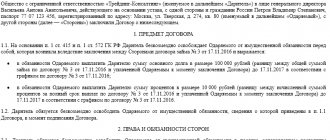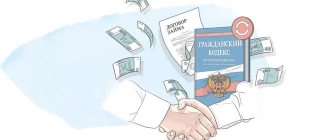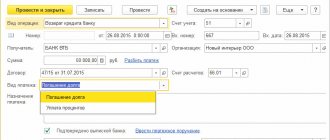Why calculate interest on a loan? A responsible borrower should calculate the interest on his loans in advance
How is interest calculated on a loan? The procedure for calculating interest is determined by the Civil Code
How to calculate interest using a calculator When calculating using an online calculator, it is enough to indicate the basic terms of the loan in the service
Calculation of simple interest With a simple scheme, interest is calculated for the entire period at a constant rate
Calculation of compound interest With a complex scheme, the amount of interest gradually increases
Calculation of interest on late payments A separate formula is used to calculate penalties
Calculation of interest in case of early repayment In case of early repayment, interest is recalculated taking into account the date of payment
Questions and answers Answers to popular questions about interest on loans
The ability to calculate interest on a loan is an important element of financial literacy. It helps to determine, even before concluding an agreement, whether you have enough money to repay the loan. And after receiving the money, calculate how much you will have to pay. You can calculate interest using several formulas that are given in this article.
Why calculate interest on a loan?
In essence, interest on a loan is a fee for using borrowed funds. Calculating the interest on a loan will help you plan your repayment in advance. If you immediately see the amount of overpayment that you will need to repay, you will be able to assess your strengths and determine whether you should take out a loan in such a situation. If the amount to be returned turns out to be too large, then you should refuse such an offer.
A preliminary calculation of the loan is also necessary for the lender. This way he will determine how much he will ultimately receive from the borrower. The lender will compare the amount received with the client’s approximate income - if it turns out to be too large, he may change the terms or refuse the loan.
Features of the loan interest calculator
The loan agreement interest calculator allows you to get fairly accurate data. This is due to the fact that an error in calculations is possible only if false information is entered. You can almost instantly get any solution from both your computer and your smartphone.
Using the service:
- easy to calculate interest on a loan online on a card or in cash;
- use the current amount of debt and periods of arrears to see the amount of overpayment;
- draw up the most optimal payment schedule if you are planning to enter into an agreement.
Now you don’t need to waste time studying all the nuances of programs from microfinance organizations. You can also compare the data received from different microfinance organizations to choose the offer that suits you best.
The online interest loan calculator can also be used by citizens who do not want to waste time on independently calculating all overpayments. Here you just need to enter information to automatically get the calculation result.
How is interest calculated on a loan?
When calculating interest on a loan, four indicators play a major role:
- Loan amount (body)
- Interest rate
- Loan term
- Frequency of payments
All these conditions, as well as the procedure for calculating interest, must be specified in the loan agreement. The procedure for calculating interest is regulated by Article 809 of the Civil Code.
Interest on the loan, unless otherwise specified in the agreement, must be accrued on the loan amount for the entire period of its actual use. Moreover, they are calculated based on the number of payments. If the debt is repaid in one amount at the end of the term, then the overpayment is considered at the end of this period.
If the debt is repaid in installments - for example, weekly or monthly payments - then interest is calculated on the date of payment on the balance of the debt. Interest is calculated by calendar days, so it is necessary to take into account the number of days in the year (365 or 366) and in the month (31, 30, 28 or 29)
If the frequency of payments is not specified in the agreement, then, according to paragraph 2 of Article 809 of the Civil Code of the Russian Federation, interest is accrued monthly until the date of repayment of the debt.
.
The form of interest payment depends on the form in which the loan was issued. Cash loans can only be repaid in cash, cash or non-cash, while property loans can be repaid in property. Article 810 of the Civil Code establishes: the loan is considered repaid at the moment of transfer of the entire amount of the debt, including interest, to the lender.
Unlike a loan, a loan can be interest-free. In this case, the borrower will have to return to the lender exactly the amount that he received from him. For a loan to be considered interest-free, the corresponding condition must be specified in the contract.
How to account for interest on a loan
Interest on loans and borrowings taken out for the purchase of an investment asset is included in the cost of the asset under the following conditions (clause 9 of PBU 15/2008):
- expenses for the acquisition, construction and production of an investment asset are recognized in accounting;
- expenses on loans for the acquisition, construction and production of an investment asset are recognized in accounting;
- work on the acquisition, construction and production of an investment asset must begin.
In other cases, interest on loans and borrowings is included in other expenses. The same rule applies to additional borrowing costs.
note
Small businesses can treat any borrowing costs as other costs. Including expenses for the purchase of investment assets (clause 7 of PBU 15/2008).
In case of suspension of the acquisition (production) of an investment asset for a period of more than three months, interest on loans received ceases to be included in the cost of this asset from the 1st day of the month following the month of suspension.
note
The period during which additional approval of technical and (or) organizational issues that arose during the acquisition, construction and (or) production of an investment asset is not considered a period of suspension of the acquisition, construction and (or) production of an investment asset (clause 11 of PBU 15/ 2008).
During this period, interest is included in other expenses. If the company resumes the acquisition (production) of an investment asset, then interest on loans is included in the cost of the asset from the 1st day of the month following the month of renewal.
How to calculate interest using a calculator?
The easiest way to calculate loan interest is to use an online calculator. This service will allow you to quickly determine the overpayment, regardless of where and how the loan was issued. It can be used both for microloans at the IFC and MCC, and for loans issued from other people and organizations.
To calculate loan overpayments in the calculator you must indicate:
- Duration – in days or as a calendar period
- Loan amount
- Interest rate
- If there are overdue payments - the amount of the penalty and the duration of the delay
- Debt repayment procedure
Based on the data received, the calculator will determine the amount of overpayment and the total amount to be returned, taking into account interest and late fees. For a long-term loan, he can also draw up a debt repayment schedule, which will separately describe each payment.
How to calculate interest yourself?
To independently calculate how much interest you will need to pay, you need to know:
- Amount of loan provided
- Amount and type of interest rate (daily, monthly or annual)
- Period for which interest is calculated
- Availability and amount of additional payments
The formula for calculating interest under a loan agreement depends on the method of calculating interest:
- Most loans use a simple formula. For calculations you will need the loan amount, the interest rate multiplied by the number of days in the year, and the number of days the money is used
- A complex formula is used for growing (capitalized) interest. To calculate them, you need to multiply the initial amount by (1+r)n, where r is the rate converted into a decimal fraction, and n is the number of payment periods.
It is more difficult to calculate interest on a loan than on a loan due to differences in the method and procedure for calculation. Here you will learn how to do it correctly.
How is simple interest calculated?
Payments for most loans are calculated using this formula:
Interest = Loan size × Annual rate / Number of days in a year × Payment period size
Let's look at calculating interest on a loan using this formula using several examples.
Example 1
Igor Ivanov takes out a loan of 25,000 rubles for 20 days. The rate is 1.5% per day. There are 365 days in a year.
First you need to calculate the annual rate - to do this, the daily rate is multiplied by the number of days in the year:
1,5 × 365 = 547,5
This means the annual rate is 547.5%. Next, let's calculate the percentages:
\(\frac{25000 \times 547.5 }{365}\times 20=\frac{136875}{365}\times 20=375\times 20=7500\) rubles - the amount of interest for the entire period
Thus, Ivanov must pay only 32,500 rubles in total.
If the contract does not specify the rate, then the refinancing rate is used to calculate interest. This is required by Article 809 of the Civil Code of the Russian Federation. The size of this rate is set by the Central Bank of the Russian Federation. From March 26, 2021, the refinancing rate is 7.25% per annum.
Example 2
Lyubov Petrova takes out a loan of 20,000 rubles for 15 days. There are 366 days in a year. The rate is not specified in the contract.
In this case, the formula does not change, but the refinancing rate is used for calculation:
20 000 × 9,75% = 1 950 1 950 / 366 = 5,33 5.33 × 15 = 79,95
This means that Petrova must pay only 20,079.95 rubles in total.
How to reflect interest on a loan issued in tax accounting
BASIS: Income tax
When taxing profits, include interest received from the borrower as non-operating income (clause 6 of Article 250 of the Tax Code of the Russian Federation).
If an interest-free loan is provided, and the borrower and the lender are interdependent persons, the lending organization must also take into account unearned income in the form of interest when calculating income tax.
If the organization uses the cash method, reflect the income on the day the interest is actually received (clause 2 of Article 273 of the Tax Code of the Russian Federation).
If an organization uses the accrual method, the tax base must be increased on the day interest is calculated under the terms of the agreement. In this case, the following conditions must be met:
— if under the agreement the borrower pays interest for more than one reporting (tax) period, accrue it on the last day of each month of the reporting (tax) period for the entire duration of the agreement;
— if the fulfillment of an obligation under a contract depends on the value (or other value) of the underlying asset, and during the period of validity of the contract interest is accrued at a fixed rate, then pay attention to the following feature. Interest at a fixed rate is calculated on the last day of each month of the reporting (tax) period, and interest actually received based on the current value (other value) of the underlying asset - on the date of fulfillment of the obligation;
— if the loan agreement is terminated during a calendar month, interest must be accrued and included in income on the last day of the agreement.
This procedure is established by paragraph 6 of Article 271 and paragraph 4 of Article 328 of the Tax Code of the Russian Federation.
An example of calculating income tax on interest on a loan issued
On June 22, 2014, Alfa CJSC issued manager A.S. Kondratiev received a loan in the amount of 36,600 rubles. at 7 percent per annum. The loan and interest repayment period is August 6, 2014. The amount of interest on the loan is 316 rubles. (RUB 36,600 × 7%: 365 days × 45 days). The organization calculates income tax quarterly and uses the accrual method.
The contract period covers two reporting periods. Therefore, the Alpha accountant calculated the amount of interest for June 2014 separately: RUB 36,600. × 7%: 365 days. × 8 days = 56 rub.
This amount is taken into account when calculating income tax for the first half of 2014. When calculating income tax for nine months, the tax base will increase by the amount of interest accrued for July and August 2014.
For July: RUB 36,600. × 7%: 365 days. × 31 days = 218 rub.
For August: RUB 36,600. × 7%: 365 days. × 6 days = 42 rub.
Situation: how to take into account interest on a loan issued for more than one reporting period when calculating income tax (accrual method)? The contract was terminated early, and therefore the interest rate is reduced
When calculating income tax, interest received from the borrower is taken into account as part of non-operating income (clause 6 of Article 250 of the Tax Code of the Russian Federation). If an organization uses the accrual method, the tax base must be increased on the day interest is calculated in accordance with the terms of the agreement.
Moreover, if the terms of the agreement stipulate that the borrower pays interest for more than one reporting period, then they should be accrued monthly throughout the entire term of the agreement at the rate in effect at the end of each month. Accrued interest increases the tax base of the reporting period to which it actually relates. This follows from the totality of the provisions of paragraph 6 of Article 271 and paragraph 4 of Article 328 of the Tax Code of the Russian Federation.
During the term of the agreement, the specified procedure for accounting for interest does not change even if the parties to the transaction provide for the possibility of changing the interest rate. For example, its reduction upon early repayment of a debt obligation. This is confirmed by the Russian Ministry of Finance in letter dated June 23, 2010 No. 03-03-06/1/426.
However, upon the occurrence of such a circumstance, that is, at the time of termination of the contract (debt repayment), the organization has the right to recalculate the interest accrued for the entire period of the contract at a new rate (clause 6 of Article 271, clause 4 of Article 328 of the Tax Code of the Russian Federation). Since the interest rate has decreased, an excessively accrued amount of interest is formed in the tax accounting of the organization, which led to an excessive payment of income tax. This amount can be taken into account as part of non-operating expenses on the date of termination of the contract (clause 1, article 54, subclause 20, clause 1, subclause 1, clause 2, article 265 of the Tax Code of the Russian Federation).
The organization does not have any obligation to adjust the tax base by filing updated income tax returns for previous reporting periods.
Similar clarifications are contained in the letter of the Ministry of Finance of Russia dated September 25, 2009 No. 03-03-06/2/179.
For loans in kind (commodity loans), interest can be set both in cash and in kind. When calculating income tax, determine the amount of interest in kind based on the contract value of the transferred property or its market price, if it differs from the contract price (clause 5 of Article 274 of the Tax Code of the Russian Federation).
VAT
When issuing a loan in cash for the amount of interest on it, there is no need to charge VAT (subclause 15, clause 3, article 149 of the Tax Code of the Russian Federation). The organization that issued the cash loan is also not obliged to issue invoices for the amount of accrued interest (subclause 1, clause 3, article 169 of the Tax Code of the Russian Federation).
Interest (both in cash and in kind) received from the borrower for using a trade loan is subject to VAT. Calculate this tax as follows:
VAT = (Interest received from the borrower - Interest calculated based on the refinancing rate in force during the period for which interest is calculated) × 18/118 or 10/110 (depending on the type of property)
Calculate the tax only after actually receiving the interest.
This procedure follows from subparagraph 3 of paragraph 1 of Article 162 and paragraph 4 of Article 164 of the Tax Code of the Russian Federation.
For the amount of interest subject to VAT, draw up an invoice in a single copy and register it in the sales book (clause 18 of section II of Appendix 5 to Decree of the Government of the Russian Federation of December 26, 2011 No. 1137).
An example of calculating VAT on interest on a loan in kind issued to an employee. Interest received in cash
On January 11, 2014, Alfa CJSC issued manager A.S. Commodity loan to Kondratiev. The subject of the contract is 1000 kg of lime worth 118,000 rubles. (including VAT - 18,000 rubles), return period - January 26, 2014. According to the terms of the agreement, the borrower must pay Alpha an amount of 10 percent per annum for using the loan. The Alpha accountant reflected the accrual of interest under the loan agreement as follows.
In January: Debit 73-1 Credit 91-1 – 485 rubles. (RUB 118,000 × 10%: 365 days × 15 days) – interest accrued on the loan for January; Debit 51 Credit 73-1 – 485 rub. – interest received on the loan for January.
The amount of interest received, to the extent that it exceeds the refinancing rate, is included in the VAT tax base. The refinancing rate effective in January 2014 is 8.25 percent. The amount of interest calculated at this rate is: 118,000 rubles. × 8.25%: 365 days. × 15 days = 400 rub.
The amount of interest exceeding the interest calculated based on the refinancing rate was: 485 rubles. – 400 rub. = 85 rub.
The accountant calculated VAT on the amount of interest exceeding the refinancing rate as follows: 85 rubles. × 18/118 = 13 rubles;
Debit 91-2 Credit 68 subaccount “Calculations for VAT” – 13 rubles. – VAT is charged on the amount of income exceeding the interest calculated at the refinancing rate.
Invoice for the amount of 85 rubles. (including VAT - 13 rubles), issued in one copy, was registered by the accountant in the sales book.
An example of calculating VAT on interest on a loan in kind issued to an organization. Interest received in cash
On January 11, 2014, CJSC Alpha issued a loan in kind to OJSC Proizvodstvennaya (VAT payer). The subject of the contract is 12,000 sheets of galvanized iron in the amount of 600,000 rubles. (including VAT - 91,525 rubles), return period - until January 26, 2014. According to the terms of the agreement, the borrower must pay Alfa an amount of 14 percent per annum for using the loan. The Alpha accountant reflected the accrual of interest under the loan agreement as follows.
In January: Debit 76 Credit 91-1 – 3452 rubles. (RUB 600,000 × 14%: 365 days × 15 days) – interest accrued on the loan for January; Debit 51 Credit 76 – 3452 rub. – interest received on the loan for January.
The amount of interest received, to the extent that it exceeds the refinancing rate, is included in the VAT tax base. The refinancing rate effective in January 2014 is 8.25 percent. The amount of interest calculated at the refinancing rate is equal to: 600,000 rubles. × 8.25%: 365 days. × 15 days = 2034 rub.
The amount of interest exceeding the interest calculated based on the refinancing rate was: RUB 3,452. – 2034 rub. = 1418 rub.
VAT on the difference between the amount of interest calculated based on the interest rate and the amount of interest calculated based on the refinancing rate amounted to: 1,418 rubles. × 18/118 = 216 rubles;
Debit 91-2 Credit 68 subaccount “VAT calculations” – 216 rubles. – VAT is charged on the amount of income exceeding the interest calculated at the refinancing rate.
Invoice for the amount of 1418 rubles. (including VAT - 216 rubles), issued in one copy, the accountant registered in the sales book.
An example of calculating VAT on interest on a loan in kind issued to an employee. Interest received in kind
ZAO Alfa issued manager A.S. Commodity loan to Kondratiev. On January 11, 2014, the borrower was given 500 sheets of galvanized iron in the amount of RUB 29,500. The cost of one sheet is 59 rubles/sheet (the same as the book value).
Interest for using trade credit is set in kind (50 sheets of galvanized iron of the same quality). According to the terms of the agreement, Kondratiev is obliged to pay interest when repaying the principal debt. On January 26, 2014, the debt to the organization was repaid along with interest. The Alpha accountant reflected the accrual of interest under the trade loan agreement as follows:
Debit 73-1 Credit 91-1 – 2950 rub. (59 rubles/sheet × 50 sheets) – interest accrued under the trade credit agreement; Debit 10 Credit 73-1 – 2950 rub. – materials were received as payment for using trade credit.
The amount of interest received, to the extent that it exceeds the refinancing rate, is included in the VAT tax base. The refinancing rate effective in January 2014 is 8.25 percent. The amount of interest calculated at the refinancing rate is: RUB 29,500. × 8.25%: 365 days. × 15 days = 100 rub.
The amount of interest exceeding the interest calculated based on the refinancing rate was: 2950 rubles. – 100 rub. = 2850 rub.
The accountant calculated VAT on the difference between the amount of interest accrued based on the terms of the agreement and the amount of interest accrued based on the refinancing rate as follows: 2850 rubles. × 18/118 = 435 rubles;
Debit 91-2 Credit 68 subaccount “VAT calculations” – 435 rubles. – VAT is charged on the amount of income exceeding the interest calculated at the refinancing rate.
Invoice for 2850 rub. (including VAT - 435 rubles), issued in one copy, was registered by the accountant in the sales book.
An example of calculating VAT on interest on a loan in kind issued to an organization. Interest received in kind
CJSC Alpha issued a loan in kind to OJSC Manufacturing Company Master. On January 11, 2014, the borrower was given 500 sheets of galvanized iron in the amount of RUB 29,500. (including VAT - 4500 rubles). The cost of one sheet without VAT is 50 rubles/sheet, with VAT – 59 rubles/sheet.
Interest for using trade credit is set in kind (50 sheets of galvanized iron of the same quality). Under the terms of the agreement, the “Master” undertakes to pay interest upon repayment of the principal debt. On January 26, 2014, the debt to the organization was repaid along with interest. The Alpha accountant reflected the accrual of interest under the trade loan agreement as follows:
Debit 76 Credit 91-1 – 2950 rub. (59 rubles/sheet × 50 sheets) – interest accrued under the loan agreement; Debit 10 Credit 76 – 2500 rub. (50 rubles/sheet × 50 sheets) – materials were received as payment for using the loan; Debit 19 Credit 76 – 450 rub. (2950 rubles - 2500 rubles) - reflects the “input” VAT on the cost of materials received in payment of interest for using the loan.
The amount of interest received, to the extent that it exceeds the refinancing rate, is included in the VAT tax base. The refinancing rate effective in January 2014 is 8.25 percent. The amount of interest calculated at the refinancing rate is: RUB 29,500. × 8.25%: 365 days. × 15 days = 100 rub.
The amount of interest exceeding the interest calculated based on the refinancing rate was: 2950 rubles. – 100 rub. = 2850 rub.
The accountant calculated VAT on the difference between the amount of interest accrued based on the terms of the agreement and the amount of interest accrued based on the refinancing rate as follows: 2850 rubles. × 18/118 = 435 rubles;
Debit 91-2 Credit 68 subaccount “VAT calculations” – 435 rubles. – VAT is charged on the amount of income exceeding the interest calculated at the refinancing rate.
Invoice for 2850 rub. (including VAT - 435 rubles), issued in one copy, was registered by the accountant in the sales book.
Situation: how to take into account when calculating the income tax VAT, which was charged on the difference between the interest calculated based on the terms of the agreement and the refinancing rate?
The amount of VAT accrued on the difference between the interest calculated under the agreement and the refinancing rate can be taken into account in reducing taxable profit.
The organization has the right to take into account as other expenses the amounts of taxes accrued as required by law (subclause 1, clause 1, article 264 of the Tax Code of the Russian Federation). An exception is the mandatory payments listed in Article 270 of the Tax Code of the Russian Federation.
Clause 19 of Article 270 of the Tax Code of the Russian Federation establishes that when calculating income tax, taxes imposed on the buyer (acquirer) of goods (work, services, property rights) are not taken into account. However, the accrual of interest under a loan agreement is not related to the purchase of goods (work, services, property rights). Consequently, the provisions of paragraph 19 of Article 270 of the Tax Code of the Russian Federation do not apply to relations under a loan agreement (accrual of interest under a loan agreement).
Since the Tax Code of the Russian Federation does not contain any other restrictions, the amount of VAT accrued on the difference between the interest calculated under the agreement and the refinancing rate can be taken into account in reducing taxable profit (subclause 1, clause 1, article 264, clause 1, article 252 Tax Code of the Russian Federation). When applying the accrual method, do this immediately after VAT is accrued to the budget (subclause 1, clause 7, article 272 of the Tax Code of the Russian Federation). When using the cash method - after paying tax (subclause 3, clause 3, article 273 of the Tax Code of the Russian Federation).
However, it is possible that following this point of view may lead to conflict with inspectors. Arbitration practice on this issue has not developed.
If an organization decides not to take into account the accrued tax in reducing taxable profit, a permanent difference and a corresponding permanent tax liability will arise in accounting (clauses 4, 7 of PBU 18/02). Reflect its accrual by posting:
Debit 99 subaccount “Permanent tax liabilities” Credit 68 subaccount “Calculations for income tax” - reflects the permanent tax liability.
simplified tax system
Regardless of the object of taxation, when calculating the single tax, include interest on the loan agreement as part of income (paragraph 3, paragraph 1, article 346.15 of the Tax Code of the Russian Federation). Do this only after the interest has actually been received from the borrower (clause 1 of Article 346.17 of the Tax Code of the Russian Federation).
An example of calculating a single tax when simplifying interest on a loan issued
On June 22, 2014, Alfa CJSC issued manager A.S. Kondratiev received a loan in the amount of 40,000 rubles. at 7 percent per annum. The loan and interest repayment period is August 6, 2014. The amount of interest on the loan is 345 rubles. (RUB 40,000 × 7%: 365 days × 45 days). According to the terms of the agreement, interest is paid along with the repayment of the principal debt. The following entries were made in Alpha's accounting:
June 22: Debit 73-1 Credit 50 - 40,000 rubles. - a loan was issued. Debit 73-1 Credit 91-1 – 61 rub. (RUB 40,000 × 7%: 365 days × 8 days) – interest accrued for June.
July 31: Debit 73-1 Credit 91-1 – 238 rubles. (RUB 40,000 × 7%: 365 days × 31 days) – interest accrued for July.
August 6: Debit 73-1 Credit 91-1 – 46 rubles. (RUB 40,000 × 7%: 365 days × 6 days) – interest accrued for August; Debit 50 Credit 73-1 – 40,000 rub. – the loan is returned; Debit 50 Credit 73-1 – 345 rub. – interest received.
The Alpha accountant reflected the amount of interest paid in the book of income and expenses for nine months.
UTII
The object of UTII taxation is imputed income (clause 1 of Article 346.29 of the Tax Code of the Russian Federation). Therefore, neither the money (property) issued to the borrower nor the interest received on the loan will affect the tax base for UTII.
Situation: is it necessary to charge income tax on the amount of interest on a loan issued if the organization is transferred to pay UTII?
Answer: yes, it is necessary.
Operations related to the provision of loans go beyond the scope of activities with which an organization can pay UTII (clause 2 of Article 346.26 of the Tax Code of the Russian Federation, letter of the Ministry of Finance of Russia dated May 14, 2008 No. 03-11-05/122). Accounting for income and expenses for such operations must be kept separately (Clause 7, Article 346.26 of the Tax Code of the Russian Federation). Include interest on the loan received from the borrower in non-operating income. The amount of this income must be taken into account when calculating income tax (clause 6 of Article 250 of the Tax Code of the Russian Federation).
OSNO and UTII
Transactions related to the provision of loans (including the receipt of interest) are taken into account according to the rules of the general taxation system. Since they do not relate to the types of activities for which UTII is applied (clause 2 of Article 346.26 of the Tax Code of the Russian Federation).
Personal income tax and insurance premiums
Regardless of what taxation system the organization that issued the loan uses, it may have responsibilities as a tax agent for personal income tax (clause 1 of Article 226 of the Tax Code of the Russian Federation). The fact is that when issuing a loan to an employee (or other citizen), the latter may receive a material benefit in the following cases:
— providing him with an interest-free loan; — providing a loan at interest if the interest rate is lower than the refinancing rate.
This is stated in subparagraph 1 of paragraph 1 of Article 212 of the Tax Code of the Russian Federation.
From the amount of material benefit received by the borrower (citizen) from saving on interest, personal income tax must be calculated (clause 1 of Article 210 of the Tax Code of the Russian Federation).
The amount of material benefit does not need to be accrued:
— contributions for compulsory pension (social, medical) insurance (part 1 of article 1, part 1 of article 7 of the Law of July 24, 2009 No. 212-FZ);
— contributions for accident insurance (clause 1 of article 20.1 of the Law of July 24, 1998 No. 125-FZ, letter of the Federal Insurance Service of Russia dated August 14, 2001 No. 02-10/05-5360).
Questions and answers
From what time does interest begin to accrue?
The loan agreement, unless otherwise stated in it, is considered real - it comes into force after the amount is transferred to the borrower. Interest on it is accrued from the day following the day of issue until the day of repayment inclusive - this is established by clause 3.14 of the Central Bank Regulations No. 236-P dated August 4, 2003.
Is loan interest subject to VAT?
No, interest on loans is a type of payment that is not subject to VAT. This is established by paragraph 3 of Article 149 of the Tax Code.
Is it possible to suspend the accrual of interest on a loan?
Yes, the loan agreement may provide for a deferment for repayment of the entire debt or for part of it - principal or interest. To obtain it, you usually need to meet certain conditions. The availability of deferred payments and the procedure for its provision, as well as other conditions, must be specified in the contract.
Which loans are always interest-free?
The loan will be considered interest-free by default if:
- It is issued between two individuals for an amount of up to 5,000 rubles and without an agreement
- It is issued in property form
In all other cases, the interest-free condition must be specified in the contract. Otherwise, the loan will be considered issued at interest at the refinancing rate (unless otherwise specified).
Which method of calculating interest is better?
It all depends on its conditions and the characteristics of the borrower. If the amount you need is small, then it is worth taking out a loan with repayment in one payment at the end of the term. It is better to take out large loans for a long period with repayment in installments. Choose the payment schedule that is most comfortable for you - once a month, once a week or once every two weeks.








